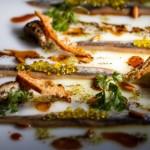The treasure of the deep
Catalonia, the Basque country and Cantabria are regions renowned for their excellent salt-packed anchovy fillets. These narrow fillets taste of the finest sea-salt; they are juicy and completely free of bones. For years, I’ve never missed an opportunity to travel to Santoña or Carril whenever I could. These are places nobody knows–well, almost nobody! But they’re places that make my heart beat that little bit faster. It’s where the best anchovies and sardines I’ve ever tasted come from. Between Bilbao and Santander, between the Laredo and San Carlos promontories, where the clear seawater meets the Santoña river delta. Three rivers empty into the delta, creating a rare and unique quality of water, a mixture of the sea salt, iodine, seaweed and plant-like particles from the rivers. The area is home to a world that is capable of making gourmets’ pulses race. This time, our meeting point is a simple guesthouse right on the coast. It’s off the main road, tucked away out of sight. I can’t remember whether it’s called “El Ancla”, “El Pescador” or “Bahia”. After many years, I met up with Ricardo again, one of the connoisseurs of Cantabria cuisine. We sat and ate everything that the lagoon and the sea offered us. Even the little appetizers, the tapas, filled me up! Anchovies in the finest olive oil, anchovies in spicy sauce, tuna in myriad variations, mussels, scallops, cockles, calamari and sea urchins. Ricardo ordered a simple house white wine to go with the meal –and it instantly matched the tapas and his story, which I followed eagerly.
“Anchovies and sardines are different types of fish”, he said, raising his index finger. “Yeah, I knew that already”, I thought. But then he took me into completely uncharted territory, explaining to me how the anchoas, as anchovies are called there, get into the can. “Today, just as in the old days, the anchovies are prepared and filleted by hand and then layered in a vessel –which in the best companies is made of wood. Once the vessel is almost full to the brim, it’s topped up with brine, covered with a round board and then weighted down with a stone, which slowly and carefully presses the anchovies down”.
Recipe by Eduard Xatruch from Restaurante Compartir in Cadaqués.

bulthaup granted the 2013 “b for bulthaup” award to the three chefs Oriol Castro, Mateu Casañas, and Eduard Xatruch, from the “Compartir” restaurant in Cadaqués, a project that he developed after the period he spent at El Bulli, as part of his quest to offer the best innovative cuisine in a unique setting.

Anchovies with black truffle, fir tree honey, and mushrooms
Preparation time: 60 minutes
Ingredients (serves 4)
- 8 anchovies
- 250 gr extra virgin olive oil
- 10 gr black truffle
- 70 gr corn oil
- 8 small mushrooms
- 200 gr olive oil
- 1 clove garlic
- Salt
- 2 gr ground black pepper
- 1/2 bay leaf
- 10 gr toasted pine nuts
- 2 thin slices of toast
- 15 gr fir tree honey
- 12 fresh chervil leaves
Instructions
1. First, mix the truffle with the corn oil in a blender. Next, vaccum pack the mix and cook it for 3 hours at 64º C. Once it’s cooked, cool to room temperature and refrigerate for 24 hours.
2. Next, peel the mushroom stems, being careful to let them keep their shape.
3. Scald the mushrooms in boiling water with a pinch of salt for five seconds and mix the oil with the garlic, bay leaf, and pepper.
4. Heat the mixture in a pan and when the garlic starts to turn golden, remove from heat. Add the scalded mushrooms.
5. Simmer on a low flame for 20 minutes, set aside, and cool to room temperature.
6. To finish and serve, place 4 anchovy fillets on each plate. Cut the mushrooms in half and place the 4 halves between the anchovies. Pour the truffle oil over the mushrooms and the bottom of the plate. Then spread the fir tree honey and the toasted pine nuts over the truffle oil. Break the toast and lean the pieces against the mushrooms. Last of all, sprinkle the dish with chervil.
anchoas Ana Maria de Cantabria












This entry has 0 Comments